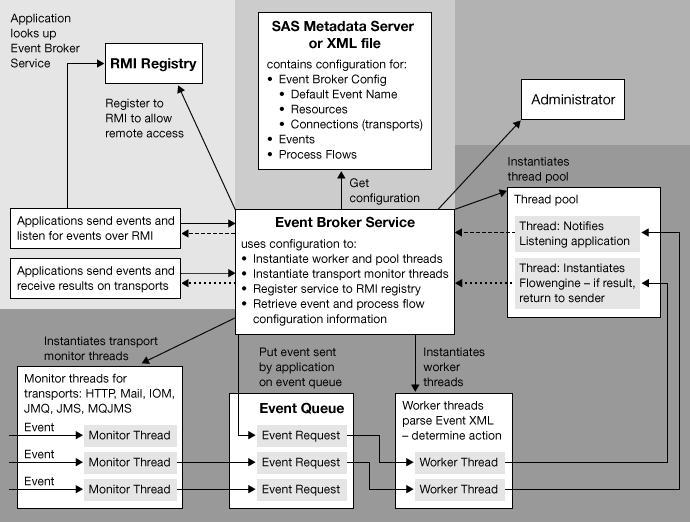Understanding the Event Broker Service
Overview of the Event Broker Service
The Event Broker Service enables you to receive external event notifications
and process them based on the name of the event that is received.
Events can be structured or unstructured as follows:
-
A structured event is specified as well-formed XML and conforms to the event message specification. (For details about the event message specification, see the SAS Foundation Services class documentation for the Event Broker Service at
http://support.sas.com/rnd/javadoc/93.) It contains information such as the name of the event, the associated properties, and the message body.
For details about the
event message specification, see the class documentation for
com.sas.services.events.broker in the SAS Foundation
Services class documentation at http://support.sas.com/rnd/javadoc/93.
-
Listens for incoming events via transports or applications. The Event Broker Service can monitor for and receive events via the following transports:If the RMI transport is enabled, the Event Broker Service registers itself to one or more RMI registries.listens for events that are sent from any JMS-compliant messaging client. This transport uses administered objects to isolate client applications from the proprietary aspects of a provider. When you configure this transport, you specify whether the administered objects are on the local file system or an LDAP directory server. The transport then uses JNDI to look up the administered objects on the local files system or LDAP directory server.
-
Determines the event name to use for event configuration information. The Event Broker Service parses the event XML to determine the event name (or names if a naming hierarchy is used) to use for event configuration information. If an unstructured event is received, the Event Broker Service uses the service configuration information to map the unstructured event to a default event name.
-
Forwards the event to the appropriate event handling agents, based on the configured event type. The Event Broker Service uses configuration information defined for the event name or default event names to determine appropriate actions to take for the event.For a broadcast event type, the Event Broker Service notifies all handling agents (process flows and listening applications) of the event as follows:For a request/response event type, the Event Broker Service notifies only one handling agent (listening application or process flow) as follows:
-
Sends a response based on the event response type. The Event Broker Service uses the event configuration to determine whether to send a response to an event.
-
If the event sender does not require a reply, the event request should specify a response type of none or ack (acknowledge). To configure an event for no response or acknowledge, you specify broadcast as the event type. For acknowledge response types, the Event Broker Service sends an acknowledge receipt to the event sender.
Note: Unstructured event requests are automatically assigned a response type of none. Therefore, for event definitions that are used to handle unstructured event requests, you must configure the response type as broadcast.Note: An event is completely qualified by its name and type. Therefore, the Event Broker Service views events as separate events if they are sent or configured with the same name, but different event types. For example, if you send an event namedAlertHighwith a response type of none to an event broker that contains an event definition namedAlertHighthat is configured as a request/response type of event, then an error is returned. -
